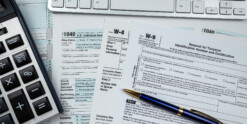We have a great new Retire Sooner Facebook Group. It’s full of people like you, trying to retire one year earlier than they ever thought they could. In only a couple of months, our followers are already approaching 700 people! We recently asked them to put forward the questions they find most concerning in today’s volatile world. I shared a couple of them on the first episode of our new podcast season and they were so good I wanted to share them with you here.
Our first question came from Greg G, and he is considering whether he should convert 401(k) or Regular IRA funds to Roth funds while still working.
What I love about our Facebook group members is that they aren’t passive spectators. They get out there on the field and play ball. By the time Greg’s question got to me, the back-and-forth conversation was already in full swing. The sense of community for folks looking to retire sooner, smarter, and happier is why I love doing what I do.
Roth conversions are a topic du jour at the moment and there are several factors to keep in mind when considering one. If we could wave a magic wand and make our money appear anywhere, the Roth would almost always be a good choice because it’s got everything you need: tax-deferred growth and tax-free distribution.
The financial world has plenty of bells and whistles, but unfortunately no magic wands.
In contrast to the Roth IRA, most American companies offer 401(k) retirement plans for their employees and it’s common for folks to accumulate large balances. That’s great, but the downside is that when they pull money out, it’s fully taxed like ordinary income.
Furthermore, when you turn 72 years old in the United States you have to do what’s called a Required Minimum Distribution (RMD) out of those retirement funds. It’s about 3.65% of whatever your Regular IRA or 401(k) is. If you’re no longer working and you’re 72, you’ve got to pull the RMD out each year, which creates a taxable event. This means you then have to fork over money every year to the IRS. As Roth IRA practitioner Ed Slott said when I interviewed him for an earlier episode of the Retire Sooner podcast, this is the point when the federal government gets tired of waiting for you to drop dead. They want their money. A harsh way to look at it, but if we can’t laugh at our own humanity, taxes are the least of our problems.
The Roth IRA doesn’t require a minimum distribution, so naturally, that’s a huge pro for the Roth IRA and a con for the Regular IRA or 401(k). The only problem is that most of the mechanics required to move your money to a Roth create tax issues, and sometimes big ones.
As an extreme example, let’s say you have $1 million in a Regular IRA or 401(k) and you want to convert all of it to a Roth. You can do it. It’s legal and ethical but is it copacetic? Not typically. Your income would go up by $1 million and your tax bracket would go through the roof. The cost to get those funds into the Roth might be more than 40%, depending on where you live. Those beautifully tanned, highly taxed Californians would probably get stuck paying over 50%.
Except for a few very nuanced exceptions that I don’t necessarily recommend, there is a significant toll attached to getting money from a Regular IRA or 401(k) into a Roth. Thus, in helping Greg with his question, the answer comes down to this: taxes today vs. taxes tomorrow.
Think about what normally happens in your 50s and 60s—you’re getting into your highest-earning years and your highest 401(k) balances. If you’re making $200,000 annually and you want to convert your 401(k) to a Roth, you might launch your tax bracket to the highest echelon of tax brackets. Suddenly you’re flying too close to the sun without enough fuel to re-enter the earth’s orbit.
Conversely, fast forward 5 years to when you’re no longer working and have a relatively low wage income such as Social Security. It’s not uncommon for a retiree to go from a super high tax bracket to a relatively low one. And if you aren’t yet 72, you won’t even have to worry about any RMDs.
You’re starting to see the problem here, right? Why convert retirement money at a 40%+ toll to get it into a Roth when in a year or two, if your income drops, you could convert at a lower tax bracket?
The joy of someday taking the tax-free money out of the Roth doesn’t always justify the immediate pain of putting it in. Of course, the IRS hopes you disagree. They might even throw you a party for creating such a tax windfall.
If you knew your future tax rate would be the same as it is today, the Roth conversion makes some sense, and even more so if you carefully converted pieces that were small enough to avoid a tax bracket tripwire explosion. This is especially true if you have a pension coming in the future that could keep your income level high when added to Social Security, rental income, or other income streams.
The majority of folks that I sit down with end up dropping into a lower tax bracket later in life. That means taxes today converted at a 40%+ toll don’t make sense because the future tax rate should fall lower.
Everyone’s situation is different, and it’s a complicated question to answer broadly. Greg G’s situation might not be the same as the other folks who weighed in on our Facebook group. The key is to remember to compare taxes today vs. taxes tomorrow and let that concept guide you. Quite often that ends up looking like a phased, scaled Roth conversion over several years. Take some time with a Roth calculator or talk with your CPA and financial advisor to help you figure out the right amounts for you. I think even Ed Slott would agree with that.
Our other question came from Jonathan. He asked, “How does the 4 Percent Plus Rule operate with a diversified income portfolio consisting of high yield bonds both domestic and international, convertibles, preferreds, real estate investment trusts (REITs), master limited partnerships (MLPs), dividend funds, and regular bonds both domestic and international?” That’s a lot to take in, so I think we need to simplify the question down to its core. “How are you supposed to diversify a portfolio using the 4 Percent Plus Rule?”
There’s no perfect answer but I think I can get close.
One of the goals of financial planning is to find a way for people to pull out the maximum amount from their portfolios each year without depletion. In other words, we want them to live their best lives without going broke.
There are a lot of different opinions about how much you can take out each year. If you follow me you know that I believe the number now sits somewhere above 4%, as explained by the 4% Plus Rule. The godfather of this rule is William Bengen, an MIT aeronautics and astronautics graduate turned CERTIFIED FINANCIAL PLANNER™. In 1994 he calculated actual stock returns and retirement scenarios for the previous 75 years and found that retirees who drew down 4% of their portfolio in the first year of retirement, adjusting every year for inflation, would likely see their money outlive them, assuming a 50% to 75% allocation in large-cap stocks, rebalanced annually with the remaining in bonds.
Based on his calculations, over 80% of the time, nest eggs lasted 45 years. In the worst-case scenario, the money lasted 30 years almost 98% of the time. In no time the 4% Rule became a road map to help people maximize spending without running out of money.
The 4% Plus Rule was William Bengen coming back to the table more than 20 years later to discover that if he added in some small-cap stocks, there was a good argument to be made that the figure could be adjusted up from 4% to 4.5%. While that ½ of 1% may not sound like a lot it’s a 12.5% raise. Imagine a $1 million portfolio. Drawing down 4% would mean $40,000 per year but that extra 0.5% would give folks an extra $5,000 annually to spend on life’s needs and wants. Of course, inflation rates would adjust the numbers a bit, but you get the point.
Remember, this is just a guide. In periods with low inflation and high market returns, such as the years after WWII, you might be able to take out more. Historically, if you retire during times with really high inflation and low market returns, using the 4% or 4% Plus Rule verbatim, without any adjustments from year to year, would not be a great idea. That’s just math.
The 4% Plus Rule is an important guide that, if used correctly, should work for most people, provided you think of it as a dynamic way to understand just how much you can pull out of your portfolio in any given year.
The other important part of the rule is making sure you have 50% to 70% of your portfolio in equities because, throughout market history, that has been the value generator. Not only do we get dividends from equities, but we also typically get growth over time. This is fundamental to protecting your purchasing power because as inflation goes higher, you’ll likely have the ability to keep up.
I think Jonathan understands the equity part of the process. He knows he needs 50% to 70% in stocks but he’s wondering what to do with the rest. Specifically, he’s curious about all these other asset classes: REITs, MLPs, dividend stocks, and international equities. My answer would be that all of those belong to the risk category.
Technically, REITs are their own category, but they typically carry just as much risk as equities. MLPs are energy pipeline companies that are great for income but as volatile or risky as any other stock, and sometimes even more. International stocks do make sense for most diversified portfolios, but they go into that 50% to 70% category in terms of equity risk.
Jonathan even asked about convertible bonds. Those are somewhere in the middle. They’re typically not as volatile as the general stock market, but they’re also not as immutable as government bonds. I’d say the same for preferred stocks, which act a lot like long-term bonds.
The fundamental principle that matters here is risk assets vs. safety assets. During big market corrections, stocks go down but most of these other risk categories do, too. It would be improbable for the market to be down 20% without REITs or MLPs following suit.
In conclusion, I wouldn’t be utilizing high yield bonds, emerging market bonds, or convertible bonds as part of the 30% to 50% I need to keep in safety assets for the 4% Plus Rule to work effectively.
Such smart questions from Greg and Jonathan make me so proud of the community the Retire Sooner team has built. Keep those questions coming and we’ll continue to educate on ways you can retire happy and sooner than you ever thought you could.
Listen to the full episode: Retire Sooner Listeners’ Q&A from the podcast where Wes answers more questions from the Facebook group.
This information is provided to you as a resource for informational purposes only and is not to be viewed as investment advice or recommendations. Investing involves risk, including the possible loss of principal. There is no guarantee offered that investment return, yield, or performance will be achieved. There will be periods of performance fluctuations, including periods of negative returns and periods where dividends will not be paid. Past performance is not indicative of future results when considering any investment vehicle. This information is being presented without consideration of the investment objectives, risk tolerance, or financial circumstances of any specific investor and might not be suitable for all investors. There are many aspects and criteria that must be examined and considered before investing. Investment decisions should not be made solely based on information contained in this article. This information is not intended to, and should not, form a primary basis for any investment decision that you may make. Always consult your own legal, tax, or investment advisor before making any investment/tax/estate/financial planning considerations or decisions. The information contained in the article is strictly an opinion and it is not known whether the strategies will be successful. The views and opinions expressed are for educational purposes only as of the date of production/writing and may change without notice at any time based on numerous factors, such as market or other conditions,













